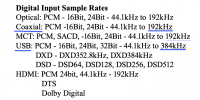Let's say that I have a USB Cable and a Coax Cable , All Digital from pre amp to a streamer transport.
Need to decide what to use.
The USB Cable can Deliver Higher Samples rates then the Coax ( See photo for example )
For better Audio enjoyment and sound , Do I need to strive for the highest delivery rates ?
As sometime I hear and enjoy better with LESS Rates.
It's a Basic question without compering the streamer or the DAC.
Thanks.
Need to decide what to use.
The USB Cable can Deliver Higher Samples rates then the Coax ( See photo for example )
For better Audio enjoyment and sound , Do I need to strive for the highest delivery rates ?
As sometime I hear and enjoy better with LESS Rates.
It's a Basic question without compering the streamer or the DAC.
Thanks.

